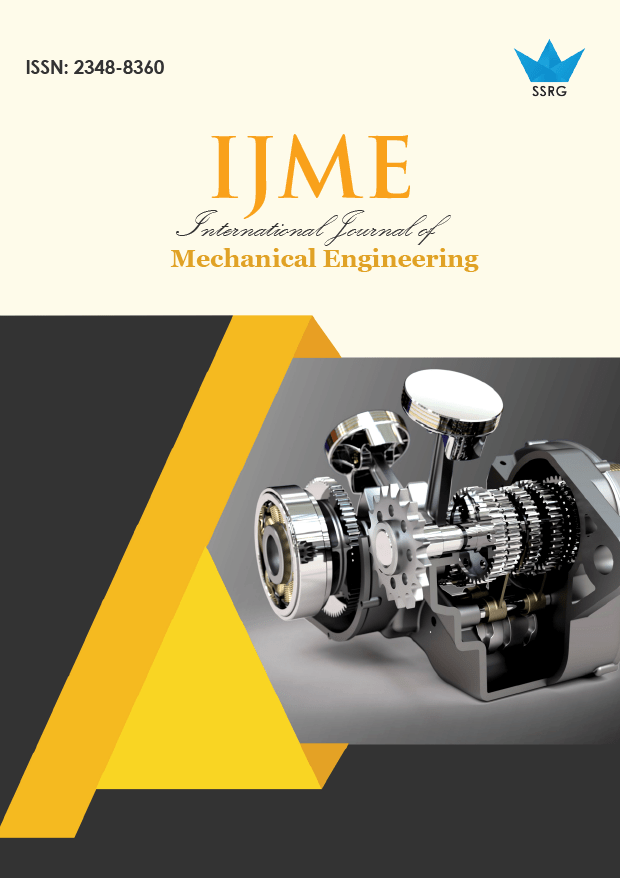Enhanced Heat Transfer (HT) in Plate and Pin Fin Heat Sinks Using Phase Change Materials (PCM-PFHS) and Geometric Modifications

| International Journal of Mechanical Engineering |
| © 2025 by SSRG - IJME Journal |
| Volume 12 Issue 1 |
| Year of Publication : 2025 |
| Authors : Amol More, Sanjeev Kumar, Sandeep Kore |
How to Cite?
Amol More, Sanjeev Kumar, Sandeep Kore, "Enhanced Heat Transfer (HT) in Plate and Pin Fin Heat Sinks Using Phase Change Materials (PCM-PFHS) and Geometric Modifications," SSRG International Journal of Mechanical Engineering, vol. 12, no. 1, pp. 127-142, 2025. Crossref, https://doi.org/10.14445/23488360/IJME-V12I1P114
Abstract:
This study investigates three new approaches to enhance heat dissipation in the plate (channel) and Round Pin Fin Heat Sinks (RPFHS) for cooling systems: rectangular heat absorbers filled with Paraffin Wax Phase Change Materials (PCM), a mix of alumina balls and PCM Paraffin Wax, and modifications in the shape using baffles. The main goal is to evaluate how effective these methods are in enhancing the thermal performance and heat dissipation abilities of PFHS in scenarios resembling practical applications, like cooling for electronics. To ensure the accuracy of comparison, the heat sinks were made of 1050 aluminum, and each configuration type had the same geometric dimensions; controlled heat flux stipulated working conditions. The core parameters such as thermal resistance, temperature distribution and overall heat dissipation efficiency were all assessed in the study. Measured thermal performance indicated improvement for all of the experimental techniques. For example now, the addition of flow baffles to the PFHS design improved heat transfer efficiency through flow turbulence, resulting in a 12% reduction in thermal resistance. The presence of alumina balls with PCM reduces thermal resistance by 18%, corroborating that the best thermal behavior occurs when paraffin wax combines with materials with the highest capacities for heat absorption. The closer to this that the contained PCM shows, the better heat transfer will be affected, as it is seen here with a 25% drop in resistance to heat transfer, all while maintaining a much more even temperature field. These results highlight the pivotal role PCM paraffin wax displays, particularly upon geometry reconfiguration, for an out-and-out positive thermal management outcome of heat sinks. Using embedded PCM paraffin wax with structural changes is a good prospect for the excellent thermal byte for working with thermal applications that require high efficiency and durable heat regulation. This study provides important insight into enhancing the designs of heat sinks where efficient heat removal is crucial, such as in electronics and thermal processing systems.
Keywords:
Heat transfer enhancement, Geometric modifications, Heat sink, Fluid dynamics, Thermal management, Pin fin heat sinks (PFHS), Paraffin Wax Phase change materials (PCM), Electronics cooling Devices.
References:
[1] Tanya Liu, and Meagan S. Mauter, “Heat Transfer Innovations and their Application in Thermal Desalination Processes,” Joule, vol. 6, no. 6, pp. 1199-1229, 2022.
[CrossRef] [Google Scholar] [Publisher Link]
[2] Davoud Jafari, and Wessel W. Wits, “The Utilization of Selective Laser Melting Technology on Heat Transfer Devices for Thermal Energy Conversion Applications: A Review,” Renewable and Sustainable Energy Reviews, vol. 91, pp. 420-442, 2018.
[CrossRef] [Google Scholar] [Publisher Link]
[3] S. Sadrabadi Haghighi, H.R. Goshayeshi, and Mohammad Reza Safaei, “Natural Convection Heat Transfer Enhancement in New Designs of Plate-Fin Based Heat Sinks,” International Journal of Heat and Mass Transfer, vol. 125, pp. 640-647, 2018.
[CrossRef] [Google Scholar] [Publisher Link]
[4] Weilin Qu, and Issam Mudawar, “Experimental and Numerical Study of Pressure Drop and Heat Transfer in a Single-Phase Micro- Channel Heat Sink,” International Journal of Heat and Mass Transfer, vol. 45, no. 12, pp. 2549-2565, 2002.
[CrossRef] [Google Scholar] [Publisher Link]
[5] Huan-Ling Liu et al., “An Experimental and Numerical Investigation of Heat Transfer Enhancement in Annular Microchannel Heat Sinks,” International Journal of Thermal Sciences, vol. 142, pp. 106-120, 2019.
[CrossRef] [Google Scholar] [Publisher Link]
[6] Maziar Dehghan et al., “Enhancing Heat Transfer in Microchannel Heat Sinks Using Converging Flow Passages,” Energy Conversion and Management, vol. 92, pp. 244-250, 2015.
[CrossRef] [Google Scholar] [Publisher Link]
[7] A. Heidarshenas et al., “Experimental Investigation of the Particle Size Effect on Heat Transfer Coefficient of Al2O3 Nano Fluid in a Cylindrical Microchannel Heat Sink,” Journal of Thermal Analysis and Calorimetry, vol. 141, pp. 957-967, 2020.
[CrossRef] [Google Scholar] [Publisher Link]
[8] Youngchan Yoon, Dong Rip Kim, and Kwan-Soo Lee, “Cooling Performance and Space Efficiency Improvement Based on Heat Sink Arrangement for Power Conversion Electronics,” Applied Thermal Engineering, vol. 164, 2020.
[CrossRef] [Google Scholar] [Publisher Link]
[9] Afsha Khan, João Calinas Correia, and David Andrew Walsh, Arthritis Pain; Rheumatoid Arthritis, Osteoarthritis, and Fibromyalgia, Chronic Pain Management in General and Hospital Practice, Springer, Singapore, pp. 483-515, 2021.
[CrossRef] [Google Scholar] [Publisher Link]
[10] N. Piroozfam, A. Hosseinpour Shafaghi, and S.E. Razavi, “Numerical Investigation of Three Methods for Improving Heat Transfer in Counter-Flow Heat Exchangers,” International Journal of Thermal Sciences, vol. 133, pp. 230-239, 2018.
[CrossRef] [Google Scholar] [Publisher Link]
[11] Vibhu Sharma, “Advancing Energy Efficiency in Solar Systems: A Comparative Study of Microchannel Heat Sink Cooling Method for Photovoltaic Cells,” European Journal of Advances in Engineering and Technology, vol. 8, no. 8, pp. 27-46, 2021.
[CrossRef] [Google Scholar] [Publisher Link]
[12] Pankaj Singh, and Anil K. Patil, “Experimental Investigation of Heat Transfer Enhancement through Embossed Fin Heat Sink under Natural Convection,” Experimental Thermal and Fluid Science, vol. 61, pp. 24-33, 2015.
[CrossRef] [Google Scholar] [Publisher Link]
[13] Hong Fan et al., “Seismic Analysis of the World’s Tallest Building,” Journal of Constructional Steel Research, vol. 65, no. 5, pp. 1206- 1215, 2009.
[CrossRef] [Google Scholar] [Publisher Link]
[14] Zhihao Zhang, Xuehui Wang, and Yuying Yan, “A Review of the State-of-the-Art in Electronic Cooling,” E-Prime - Advances in Electrical Engineering Electronics and Energy, vol. 1, pp. 1-26, 2021.
[CrossRef] [Google Scholar] [Publisher Link]
[15] A.M. Bayomy, and M.Z. Saghir, “Experimental Study of Using γ-Al2O3–Water Nanofluid Flow through Aluminum Foam Heat Sink: Comparison with Numerical Approach,” International Journal of Heat and Mass Transfer, vol. 107, pp. 181-203, 2017.
[CrossRef] [Google Scholar] [Publisher Link]
[16] Vishwjeet Choudhary, Manoj Kumar, and Anil Kumar Patil, “Experimental Investigation of Enhanced Performance of Pin Fin Heat Sink with Wings,” Applied Thermal Engineering, vol. 155, pp. 546-562, 2019.
[CrossRef] [Google Scholar] [Publisher Link]
[17] Tzer-Ming Jeng, Sheng-Chung Tzeng, and Qiong-Yao Huang, “Heat Transfer Performance of the Pin–Fin Heat Sink Filled with Packed Brass Beads under a Vertical Oncoming Flow,” International Journal of Heat and Mass Transfer, vol. 86, pp. 531-541, 2015.
[CrossRef] [Google Scholar] [Publisher Link]
[18] Seyyed Abdolreza Fazeli et al., “Experimental and Numerical Investigation of Heat Transfer in a Miniature Heat Sink Utilizing Silica Nanofluid,” Superlattices and Microstructures, vol. 51, no. 2, pp. 247-264, 2012.
[CrossRef] [Google Scholar] [Publisher Link]
[19] Imran Zahid et al., “Experimental Investigation for Thermal Performance Enhancement of Various Heat Sinks Using Al2O3 NePCM for Cooling of Electronic Devices,” Case Studies in Thermal Engineering, vol. 41, pp. 1-13, 2023.
[CrossRef] [Google Scholar] [Publisher Link]
[20] Alireza Mirshekar et al., “Experimental Study of Heat Transfer Enhancement Using Metal Foam Partially Filled with Phase Change Material in a Heat Sink,” Journal of Energy Storage, vol. 60, 2023.
[CrossRef] [Google Scholar] [Publisher Link]
[21] Thamir K. Ibrahim et al., “Experimental and Numerical Investigation of Heat Transfer Augmentation in Heat Sinks Using Perforation Technique,” Applied Thermal Engineering, vol. 160, 2019.
[CrossRef] [Google Scholar] [Publisher Link]
[22] Yan Fan et al., “Experimental Investigation on Heat Transfer and Pressure Drop of a Novel Cylindrical Oblique Fin Heat Sink,” International Journal of Thermal Sciences, vol. 76, pp. 1-10, 2014.
[CrossRef] [Google Scholar] [Publisher Link]
[23] Alireza Aldaghi et al., “An Experimental Study Integrated with Prediction Using Deep Learning Method for Active/Passive Cooling of a Modified Heat Sink,” Applied Thermal Engineering, vol. 221, 2023.
[CrossRef] [Google Scholar] [Publisher Link]
[24] Benjamin Rimbault, Cong Tam Nguyen, and Nicolas Galanis, “Experimental Investigation of CuO–Water Nanofluid Flow and Heat Transfer Inside a Microchannel Heat Sink,” International Journal of Thermal Sciences, vol. 84, pp. 275-292, 2014.
[CrossRef] [Google Scholar] [Publisher Link]
[25] Uwe Scheithauer et al., “Potentials of Numerical Methods for Increasing the Productivity of Additive Manufacturing Processes, Ceramics, vol. 6, no. 1, pp. 630-650, 2023.
[CrossRef] [Google Scholar] [Publisher Link]
[26] Seyyed Mohammad Hosseini Hashemi et al., “Study of Heat Transfer Enhancement in a Nanofluid-Cooled Miniature Heat Sink,” International Communications in Heat and Mass Transfer, vol. 39, no. 6, pp. 877-884, 2012.
[CrossRef] [Google Scholar] [Publisher Link]
[27] Robert Tucker et al., “Experimental Investigation of Orientation and Geometry Effect on Additive Manufactured Aluminium LED Heat Sinks under Natural Convection,” Thermal Science and Engineering Progress, vol. 23, 2021.
[CrossRef] [Google Scholar] [Publisher Link]
[28] Seyed Soheil Mousavi Ajarostaghi et al., “A Review of Recent Passive Heat Transfer Enhancement Methods,” Energies, vol. 15, no. 3, pp. 1-60, 2022.
[CrossRef] [Google Scholar] [Publisher Link]
[29] M. Muneeshwaran, Ming-Kun Tsai, and Chi-Chuan Wang, “Heat Transfer Augmentation of Natural Convection Heat Sink through Notched Fin Design,” International Communications in Heat and Mass Transfer, vol. 142, 2023.
[CrossRef] [Google Scholar] [Publisher Link]
[30] A. Anusha, D. Sathya Narayana Rao, and G. Saxena, “Enhancing the Efficiency and Speed of Heat Transfer Using Shell and Tube Heat Exchanger Design,” International Journal of Scientific Methods in Engineering and Management, vol. 1, no. 2, pp. 1-12, 2021.
[CrossRef] [Publisher Link]
[31] Cheng-Hung Huang, and Wei-Yu Chen, “A Natural Convection Horizontal Straight-Fin Heat Sink Design Problem to Enhance Heat Dissipation Performance,” International Journal of Thermal Sciences, vol. 176, 2022.
[CrossRef] [Google Scholar] [Publisher Link]
[32] Chandan Swaroop Meena et al., “Review on Boiling Heat Transfer Enhancement Techniques,” Energies, vol. 15, no. 15, pp. 1-15, 2022.
[CrossRef] [Google Scholar] [Publisher Link]
[33] Oguz Kaan Yagci et al., “An Experimental Study on the Performance of PCM-Based Heat Sink with Air for Thermal Regulation of PVs,” Solar Energy, vol. 278, 2024.
[CrossRef] [Google Scholar] [Publisher Link]
[34] Zhiyi Wang et al., “Seismic Fragility Analysis with Artificial Neural Networks: Application to Nuclear Power Plant Equipment,” Engineering Structures, vol. 162, pp. 213-225, 2018.
[CrossRef] [Google Scholar] [Publisher Link]
[35] Ahmed Abdulnabi Imran, Nabeel Sameer Mahmoud, and Hayder Mohammad Jaffal, “Numerical and Experimental Investigation of Heat Transfer in Liquid Cooling Serpentine Mini-Channel Heat Sink with Different New Configuration Cases,” Thermal Science and Engineering Progress, vol. 6, pp. 128-139, 2018.
[CrossRef] [Google Scholar] [Publisher Link]
[36] Ndah Abdulrahman Alpha, and Aondoyila Kuhe, Heat Transfer Enhancement on Staggered Perforated Circular Pin-Fin Heat Sink: An Experimental Assessment, Current Research in Thermal Conductivity, IntechOpen, 2024.
[CrossRef] [Google Scholar] [Publisher Link]
[37] Adeel Arshad et al., “Experimental Investigation of PCM Based Round Pin-Fin Heat Sinks for Thermal Management of Electronics: Effect of Pin-Fin Diameter,” International Journal of Heat and Mass Transfer, vol. 117, pp. 861-872, 2018.
[CrossRef] [Google Scholar] [Publisher Link]

 10.14445/23488360/IJME-V12I1P114
10.14445/23488360/IJME-V12I1P114